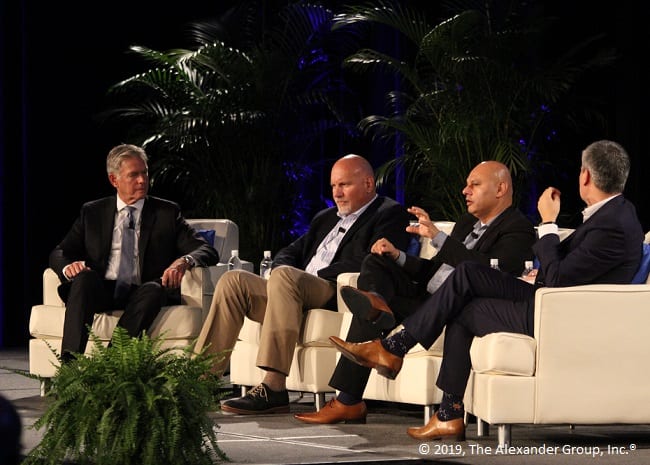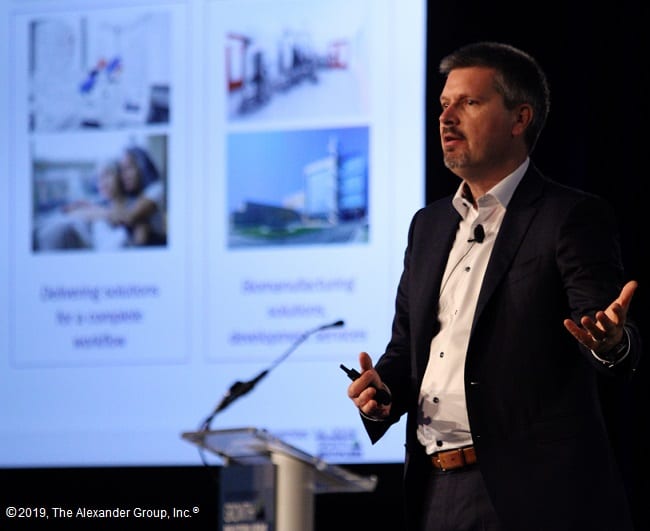
From left: Gary Tubridy, John Skowronski, Anshu Mehrotra, Emmanuel Ligner
The Presidential Panel at the 2019 Executive Forum explored how to best take advantage of this new customer environment and build a sustainable revenue ecosystem. The panel consisted of:
Emmanuel Ligner (EL), President and CEO, GE Healthcare Life Sciences
GE Healthcare Life Sciences provides solutions to life sciences researchers and biopharmaceutical manufacturers. With 6,500 team members across the globe, the organization recently became a stand-alone company. With their focus on the patient, Emmanuel believes the company can help change the economics of the entire healthcare system.
Anshu Mehrotra (AM), Group President, ITW Welding
ITW Welding is one of seven ITW industrial segments. Among their largest customers are companies like Ford and John Deere. Four years ago the business shifted from being distribution-centric to focusing every product on the end customer. They embrace the philosophy that an order is only a piece of paper until the customer gets what they want in the way they want it.
John Skowronski (JS), President of Sales & Operations, N.A., Stanley Security/Black & Decker
When you think of Stanley, most people think of tools. Originally a manufacturer of screws, Stanley is now the largest tool company in the world. Fifteen years ago, management looked to security services as a source of recurring revenue. Several acquisitions later, Stanley is now the #2 provider of security systems across the globe.

From left: Gary Tubridy, John Skowronski, Anshu Mehrotra, Emmanuel Ligner
Emmanuel, Anshu and John shared their thoughts on several important topics:
EL: A revenue ecosystem doesn’t stop with marketing, sales or service alone. Value is not just in one part of the organization. It needs to be everybody.
AM: You have to be customer-centric and really consider how the customer would consume or use the product. We expect our field reps to know the customers as well as they know us.
JS: How do you get all the individual sellers, marketers and service personnel to play with each other in the sandbox and form a partnership? In today’s world, revenue is everybody’s job and at the end of day, it is all about working seamlessly across functions. You need to create a true revenue team within the organization.

Emmanuel Ligner, GE Healthcare Life Sciences
JS: I, as the revenue leader, set the strategic direction of the business. You want ambitious people in sales, but with the same goal of building this unity.
AM: Leadership and communication set the tone at every level, not just the top. First-line sales manager, business leader, functional leader─all aligned around profitable revenue.
EL: No one person at my organization can say I am the revenue leader, we all are. The leaders in the company have to provide others the ability to lead, too. It is my job to make sure the company is still here in the future, with leaders that will care and keep it moving forward.
AM: Our ability to win a sale is dictated by our ability to understand the customer. 78% of decision-making in our industry happens before they show up in the store of our distributor. Our role is to generate awareness, drive acceleration to our brand, and get them to the nearest fulfillment center.
EL: Education is critical within our industry. Scientific people understand that. We spend a lot of time making sure the brand is known at an educational level. It increases the odds that once those students enter the industry, they’ll be familiar with the brand and inclined to use our solutions.
JS: We invest a lot in making it easier for customers to find us. Once we know more about who is coming to us, we can cater our solutions to their security or tool needs.
JS: Our industry got lazy on how it develops and mentors talent. My organization is changing that equation by doing a better job with early career individuals. This helps us cultivate the right talent with the right skill sets.
AM: It all starts with talent acquisition, then development and finally retention. The companies that acquire the best talent, nurture with the best leaders and keep those team members long-term will be the winners. Strategy and execution are only as good as the people we have in the organization.
EL: Do I hire scientists and teach them to sell? Or commercial sellers and teach them science? A good mix is important for us. Make sure your employees are satisfied and happy with their work and you will attract and keep the right talent.
EL: You need a culture where people can be themselves. You want to hire the best and create an environment where they can be happy in the organization.
AM: It’s about attraction, but also the diversity of our existing talent. It’s about diversity of thought. We believe strongly in empowerment and accountability to create an entrepreneurial culture. People have the authority, the right, the expectation to make the right decision, but we have to create a culture that allows that mindset.
JS: It doesn’t need to be a one-size-fits-all. Early career individuals want a sense of purpose. Culture is what you feel when you wake up in the morning. The best environment is one where people have a sense of purpose.
Discover more about Alexander Group Leadership Events. Or contact our events team to secure your spot at the 2020 Leadership Series.
Are you building a sustainable revenue ecosystem at your firm? Alexander Group can help! Contact a revenue growth leader today.